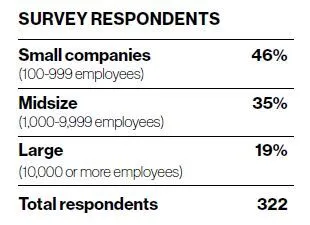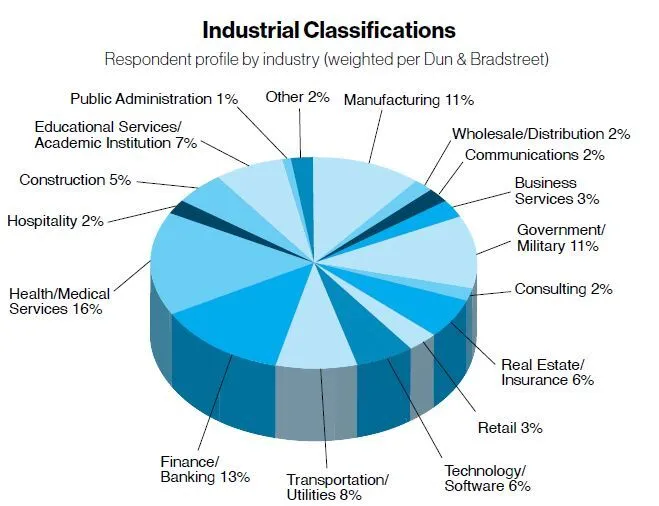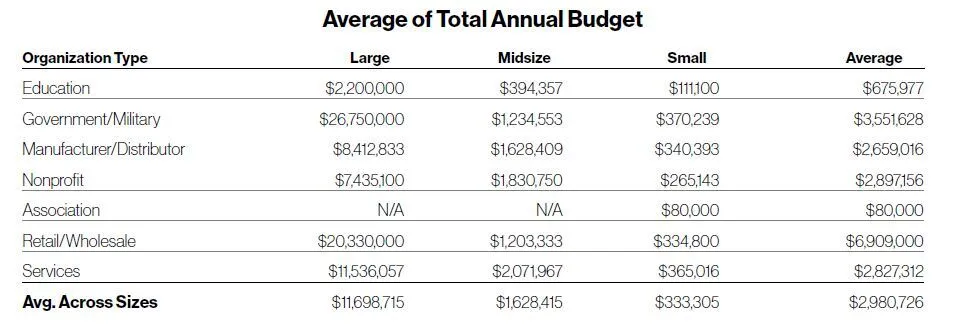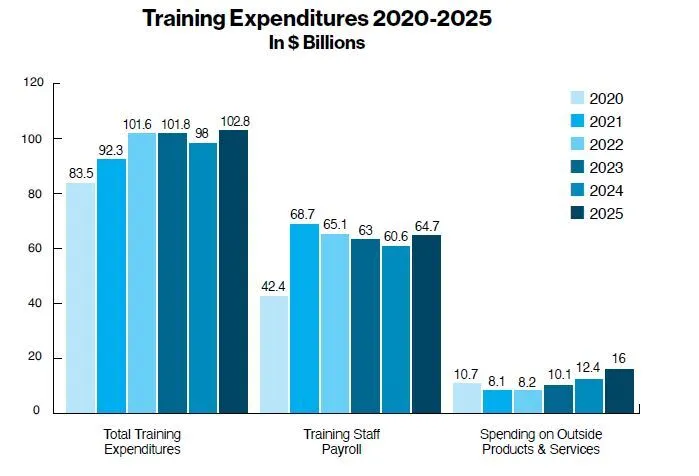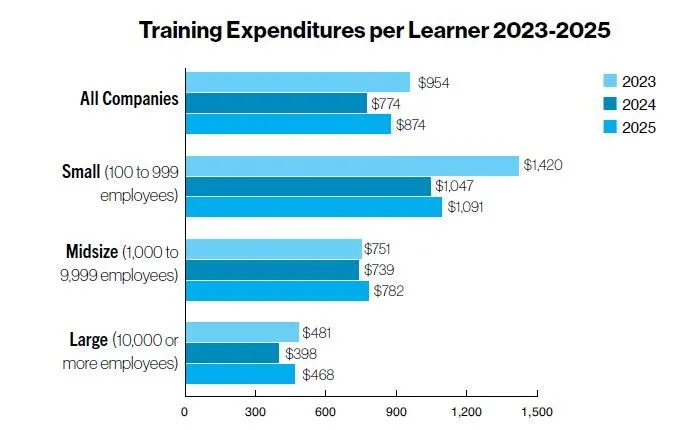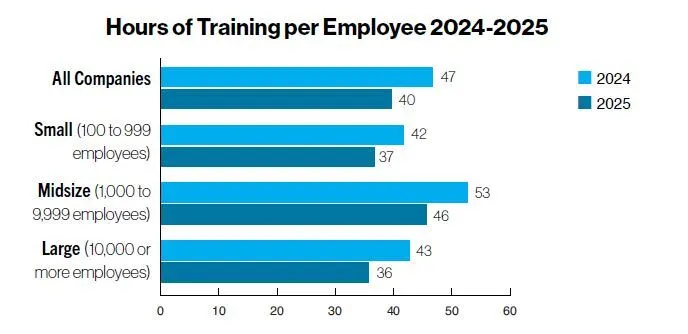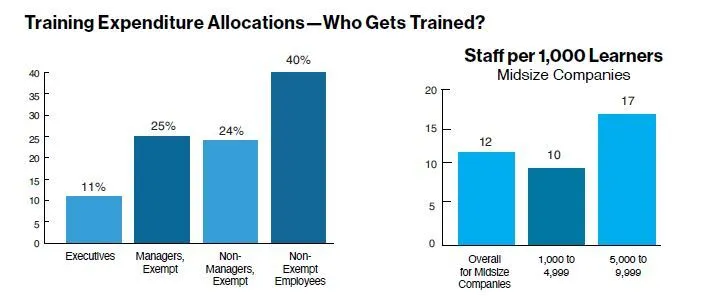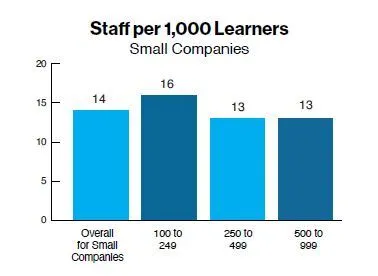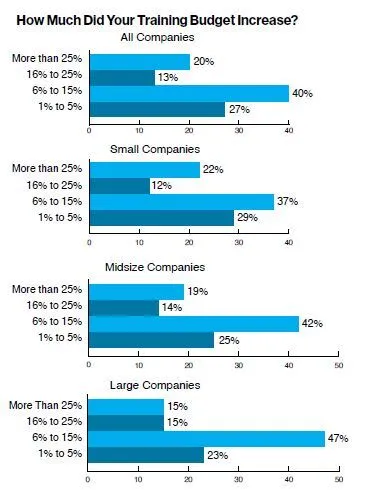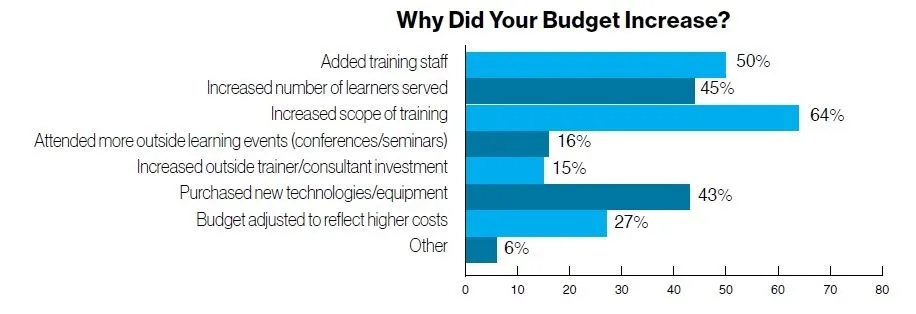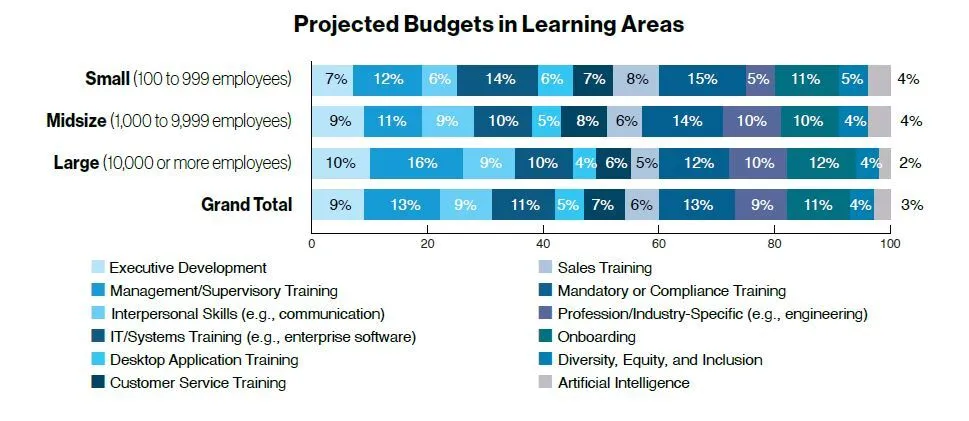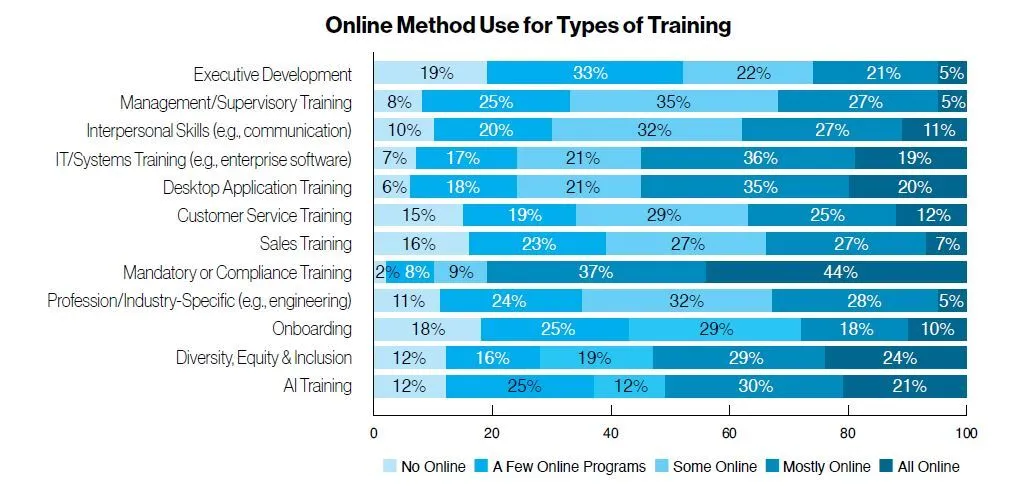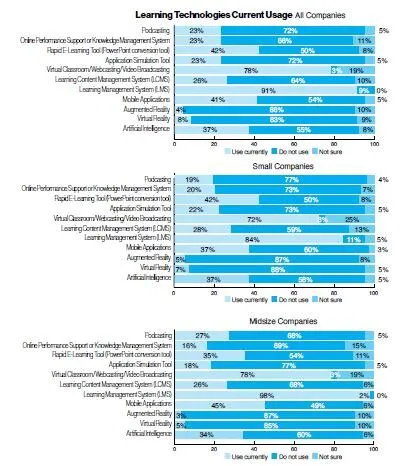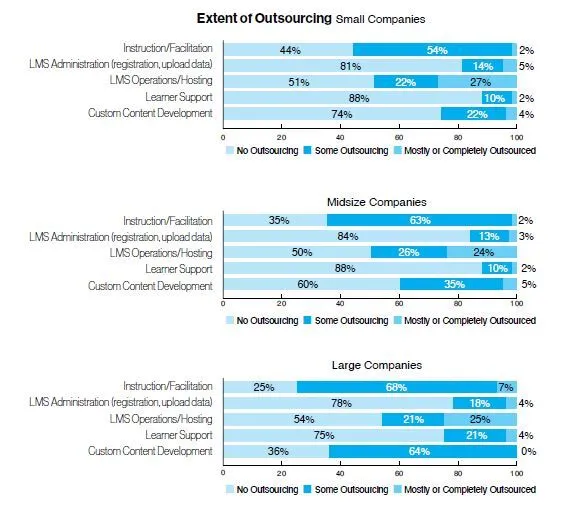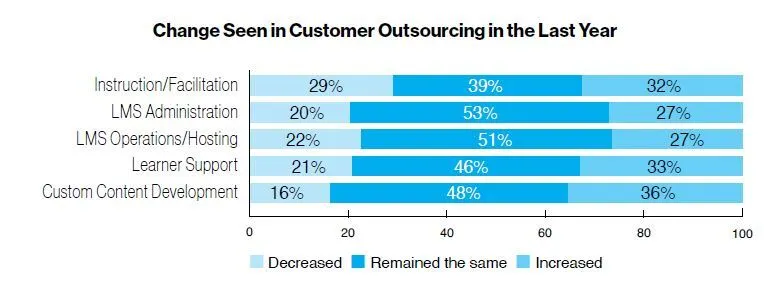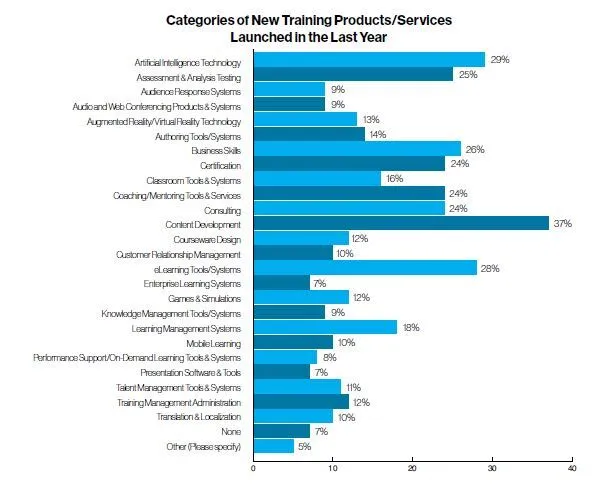ABOUT THIS STUDY
Now in its 44th year, The Industry Report is recognized as the training industry’s most trusted source of data on budgets, staffing, and programs. This year, the study was conducted by an outside research firm April-July 2025, when members from the Training magazine database were e-mailed an invitation to participate in an online survey. Only U.S.-based corporations and educational institutions with 100 or more employees were included in the analysis.
The data represents a cross-section of industries and company sizes.
Note that the figures in this report are weighted by company size and industry according to a Dun & Bradstreet database available through Hoovers of U.S. companies. Since small companies dominate the U.S. market, in terms of sheer numbers, these organizations receive a heavier weighting, so that the data accurately reflects the U.S. market.
About Survey Respondents:
- 51% are managers or above in the organization
- 25% are developers or instructional designers
- 22% are mid- to low-level (based on title selection) associates
- 64% determine the need for purchasing products and services
- 25% set the budget
- 35% manage requests for proposals/bids
- 68% recommend the purchase
- 21% have the final purchase decision
TRAINING EXPENDITURES
Fueled by an influx of new companies, U.S. training expenditures jumped 4.9 percent to $102.8 billion in 2025. Payroll also rose by nearly 7 percent to $64.7 billion. And spending on outside products and services increased 29 percent to $16 billion. Other training expenditures (i.e., travel, facilities, equipment) declined to $22.1 billion from $25 billion in 2024.
The training expenditure figures were calculated by projecting the average training budget to a weighted universe of 152,572 companies, using a Dun & Bradstreet database available through Hoovers of U.S. organizations with more than 100 employees.
Note: Although small companies have the smallest annual budgets, there are so many of them (113,133) that they account for almost one-third of the total budget for training expenditures.
For the first time, the survey also included questions for training solution providers. See pp. 32-33 for their input on new products/ services launched, changes in customer behaviors/expectations and outsourcing, and learning and development (L&D) trends they see for 2026. Average training expenditures for large companies decreased from $13.3 million in 2024 to $11.7 million in 2025. The number for midsize companies remained just about flat at $1.6 million. Small companies ticked down from $374,207 to $333,305.
Some 31 percent of organizations said they increased staff from the year before (down from 38 percent), while 53 percent said the level remained the same (vs. 49 percent last year). Some 16 percent said it was lower. Manufacturers/distributors had the highest payrolls across all size divisions ($1.7 million). This year, midsize companies spent only about one-quarter as much as large companies, and small companies spent about one-third as much as midsize companies. The average payroll figure for large companies was $4 million; for midsize organizations, it was $965,731; for small companies, it was $320,586.
For those who reported an increase in their training staff, the average increase was 19 people, up from 15 in 2024. For those who reported a decrease in their staff, the average decrease was 8 people—down significantly from 45 last year. Some 41 percent of respondents cited lack of resources/personnel as their biggest training challenge.
Other training expenditures decreased this year to $22.1 billion from $25 billion in 2024. Such expenditures can include travel, training facilities, in-house training development, and equipment. On average, organizations spent 13 percent of their budget or $290,987 (up from $268,397 last year) on learning tools and technologies. Large services and retail/wholesale organizations had the largest budgets for learning tools ($2 million and $1.1 million, respectively). Large education organizations spent the greatest proportion of their budgets (22 percent) on tools.
Looking ahead, the most frequently anticipated purchases are games and simulations (up to 49 percent from 46 percent last year); online learning tools and systems (at 45 percent vs. 39 percent last year); business skills (44 percent vs. 39 percent last year); classroom tools and systems (34 percent vs. 29 percent last year); courseware design (remaining at 33 percent); and assessment and analysis testing (30 percent vs. 31 percent last year). Coaching/mentoring remained at 28 percent. Consulting was at 26 percent vs. 25 percent last year. Certification came in at 18 percent vs. 17 percent last year. Content development increased 1 percent to 17 percent. Learning management systems fell 1 percent to 14 percent. Augmented/virtual reality tech came in at 10 percent vs. 8 percent last year.
Overall, on average, companies spent $874 per learner this year compared with $774 per learner in 2024. Retailers/wholesalers spent the most per learner this year ($1,046), followed by services organizations ($944). Small ($1,091) and midsize ($782) companies spent more per learner than large corporations ($468).
On average, employees received 40 hours of training per year vs. 47 hours last year. Services organizations offered the greatest average number of hours overall across business types (51), while large services organizations had the highest average number of hours by company size (62).
Companies continued to devote the bulk of their training expenditures to training non-exempt employees (40 percent in 2025 vs. 37 percent in 2024).
The average training budget for large companies was $11.7 million, while midsize companies allocated an average of $1.6 million, and small companies dedicated an average of $333,305.
DEFINITIONS
▸ Total training spending: All training-related expenditures for the year, including training budgets, technology spending, and staff salaries.
▸ Training staff payroll: The annual payroll for all staff personnel assigned to the training function.
▸ Outside products and services: Annual spending on external vendors and consultants, including all products, services, technologies, off-the-shelf and custom content, and consulting services.
TRAINING BUDGET
This year, the number of companies reporting that their training budgets increased dipped 5 percent to 41 percent. Those indicating their budgets decreased ticked up to 16 percent from 14 percent in 2024. Some 43 percent said their budget remained the same vs. 40 percent last year. Manufacturers/distributors and services organizations had the greatest tendency for budget gains. Midsize companies showed the greatest number of decreased budgets (23 percent vs. 12 percent for small companies and 13 percent for large ones).
Most of the budget increases were modest—less than 16 percent. Some 27 percent of organizations reported increases in the 1 to 5 percent range, while 40 percent saw increases in the 6 to 15 percent range (vs. 37 and 32 percent, respectively, last year). Some 33 percent reported increases in the 16-plus percent range (vs. 31 percent in 2024). Most respondents who reported an increase in their training budgets attributed it to the following reasons:
- Increased scope of training programs (65 percent vs. 57 percent last year)
- Added training staff (50 percent vs. 52 percent in 2024)
- Increased number of learners served (45 percent vs. 44 percent last year)
- Purchased new technologies/equipment (43 percent vs. 38 percent in 2024)
This year, more than half of the respondents who reported training budget decreases cited a drop of 16 or more percent. Of that group, 34 percent reported a more than 25 percent decrease. Some 26 percent reported budget decreases between 6 and 15 percent (vs. 49 percent last year). Some 58 percent cited budget cuts due to economic uncertainty for the decrease vs. 74 percent last year. Others pointed to a budget adjusted to reflect lower costs and/ or new training efficiencies (36 percent vs. 26 percent in 2024). This was followed by:
On average, organizations allocated the biggest portions of their training budget to mandatory compliance training and management/supervisory training (both at 13 percent). IT/systems training and onboarding were next at 11 percent.
Like the last 13 years, the highest percentage of organizations (30 percent) said management/ supervisory training will receive more funding and resources than the year before. This was followed by AI training (25 percent), interpersonal skills (22 percent), and onboarding (21 percent). Those reporting an increase in diversity, equity, and inclusion (DEI) funding declined significantly from 24 percent to 3 percent in the wake of new government policies. While 52 percent said nothing will change with their DEI programs, 11 percent said they will scale them back, 8 percent will reduce spending on them, and 6 percent will eliminate such programs.
The highest priorities for training in terms of allocating resources in 2026 are: increasing the effectiveness of training programs (28 percent vs. 30 percent last year), and increasing learner usage of training programs and reducing costs/improving efficiency (both at 19 percent vs. 22 and 16 percent, respectively in 2024).
Overall, 34 percent of training hours were delivered via online or computer-based technologies, the same as last year. Other delivery methods included:
- Some 28 percent of training hours were delivered by a stand-and-deliver instructor in a classroom setting—up a tick from 27 percent last year.
- Another 24 percent of hours were delivered with virtual classroom/Webcasting (down from 27 percent in 2024).
- Blended learning techniques accounted for 22 percent of hours, down from 24 percent last year.
- Some 6 percent of training hours were delivered via mobile devices vs. 3 percent in 2024. This year, 6 percent of training hours were delivered via social learning vs. 5 percent last year. Both augmented and virtual reality hours dipped from 3 percent to less than 1 percent this year. Artificial intelligence hours ticked up from .8 percent to 2 percent.
The highest delivery method usage percentages were in the 10 to 29 percent range: virtual classrooms/Webcasts at 51 percent, followed by instructor-led classrooms at 49 percent, blended learning at 46 percent, online training at 39 percent, and social learning at 30 percent.
Mandatory or compliance training continued to be done mostly online, with 92 percent of organizations doing at least some of it online and 45 percent entirely online (down from 48 percent last year). Companies do at least some or more online training for: IT/systems training (76 percent); desktop application training (75 percent); diversity, equity, and inclusion training (72 percent); interpersonal skills (70 percent); management/supervisory training (67 percent); customer service training (66 percent); profession/industryspecific training (64 percent); AI training (63 percent); sales training (61 percent); and onboarding (56 percent). Online training was least used for executive development (48 percent).
For the upcoming year, 71 percent of companies plan to stay the course when it comes to the amount of in-person vs. remote training they provide. Slightly more (15 percent) plan to increase in-person training as plan to increase remote training (13 percent). The areas expected to see the greatest increase in in-person training are management/supervisory training (24 percent), interpersonal skills training (21 percent), and executive development (20 percent).
In terms of technology usage, of the 11 learning technologies presented, the most often used included:
- Learning management systems (LMSs) at 89 percent vs. 90 percent last year, followed by virtual classroom/ Webcasting/video broadcasting at 77 percent (down from 79 percent last year). Some 90 percent of large and 97 percent of midsize companies currently use LMSs vs. 84 percent of small ones.
- Rapid eLearning tools (42 percent) and mobile applications (41 percent) vs. 33 percent last year
- Artificial intelligence, which jumped from 25 percent last year to 37 percent this year
- Learning content management systems (LCMSs) at 26 percent (up a bit from 25 percent last year)
- Application simulation tools, online performance support (EPSS)/knowledge management systems, and podcasting all at 23 percent vs. 26, 18, and 14 percent, respectively, in 2024
TRAINING OUTSOURCING
The average expenditure for training outsourcing was essentially flat: $217,178 in 2025 vs. $241,311 in 2024. Large companies on average spent $409,778 vs. $309,431 for midsize companies and $112,412 for small ones. An average of 7 percent of the total training budget was spent on outsourcing in 2025 vs. 6 percent in 2024.
On average, 26 percent of companies mostly or completely outsourced LMS operations/hosting (down from 27 percent last year), while learner support (86 percent) and LMS administration (82 percent) largely were handled in-house.
More instruction/facilitation is outsourced than handled in-house (62 percent vs. 38 percent). Across all the topic areas, small and large companies outsourced about the same (36 percent) and midsize companies 10 percent more.
The level of outsourcing is expected to stay relatively steady in 2026—some 85 percent of organizations said they expect to stay the same in the outsourcing area. The percentage of companies expecting to increase outsourcing is roughly the same as those expecting to outsource less (7 vs. 8 percent). Half of respondents said they don’t plan to outsource learner support or LMS administration in the next 12 months.
With respect to company size, 42 percent of small and midsize companies expect to keep the same level of outsourcing in 2026 vs. 43 percent of large organizations. Midsize and small companies are slightly more likely to report that they don’t and won’t outsource.
SOLUTION PROVIDER INSIGHTS
For the first time, Training’s Industry Report survey asked for input from training solution providers. Some 164 providers of training products, services, and/or solutions offered input on their operations. The greatest number focus on professional/ industry-specific training (27 percent), leadership development (26 percent), and interpersonal skills (13 percent). They tend to predominately use blended training (68 percent), virtual (66 percent) or instructor-led (59 percent) classrooms, and online training (57 percent). More companies reported increased revenue (42 percent) than decreased (24 percent) in the last year.
The majority of new training products/services respondents launched were in content development (37 percent), artificial intelligence (29 percent), eLearning tools/systems (28 percent), and business skills (26 percent).
For the most part, respondents said the amount of training-related activities their customers outsourced remained the same. Custom content (36 percent increased), learner support (33 percent increased), and instruction/facilitation (32 percent increased) were the categories they saw with the most growth in outsourcing.
Training solution providers indicated they saw the biggest changes in customer expectations for effective training that produces business outcomes (58 percent said expectations increased) and customer interest in implementing emerging training technologies (56 percent said interest went up). Respondents saw the largest decrease in customer budgets for customized training products/services (34 percent said budgets were lower).
Not surprisingly, the most common trends training solutions providers perceive for training in 2026 relate to artificial intelligence (AI). They include:
- AI and better instructional design for more effective training
- Adaptive learning with AI tutors
- AI and Emotional Intelligence (EQ) integration in training
- AI as both curriculum content and development tools
- Custom content creation using AI
- AI implementation and guidance in learning programs
- AI-infused learning and recognition of cohort-based learning benefits
- AI-curated hyper-personalized learning paths
- Chatbots and virtual coaches providing real-time guidance
- Other trends respondents are seeing include:
- Emphasis on ROI in learning and development
- Leadership buy-in and involvement as a critical success factor
- A return to basics due to staff turnover in organizations
- More employee wellness and self-care programs
- Virtual events for cost-effectiveness and productivity
- Predictive analytics identifying skill gaps before they become performance issues
- Gamification and personalized learning experiences
- Blockchain credit systems for skills accumulation and formal academic qualifications
- Continuous learning culture integrated with productivity tools for bite-sized learning


